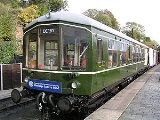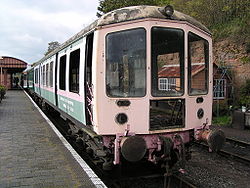
British Rail Derby Lightweight
Encyclopedia

British Rail
British Railways , which from 1965 traded as British Rail, was the operator of most of the rail transport in Great Britain between 1948 and 1997. It was formed from the nationalisation of the "Big Four" British railway companies and lasted until the gradual privatisation of British Rail, in stages...
Derby Lightweight diesel multiple unit
Diesel multiple unit
A diesel multiple unit or DMU is a multiple unit train consisting of multiple carriages powered by one or more on-board diesel engines. They may also be referred to as a railcar or railmotor, depending on country.-Design:...
s, were the first such trains to be built en-masse for British Railways. The units were built at BR's Derby
Derby Carriage and Wagon Works
Derby Carriage and Wagon Works was built by the Midland Railway in Derby, England. The plant has been through many changes of ownership and is currently owned by Bombardier Transportation, a subsidiary of Bombardier Inc. of Canada. As of 2011 it is the only remaining passenger rolling stock...
Works from 1954 to 1955. The units were built in various formations, including 12 power-twin 2-car units, 84 power-trailer 2-car units, and four 4-car units. The two single car units were originally built as a two-car unit and then split two years later when demand came about. Contemporaneous with these units was the unique Battery Electric Multiple Unit
British Rail BEMU
The Battery Electric Multiple Unit was an experimental two-car multiple unit, built at the same time and in the same style as the prototype Derby Lightweight Diesel multiple units....
.
Operations
The first units were introduced on services around the West RidingWest Riding of Yorkshire
The West Riding of Yorkshire is one of the three historic subdivisions of Yorkshire, England. From 1889 to 1974 the administrative county, County of York, West Riding , was based closely on the historic boundaries...
of Yorkshire
Yorkshire
Yorkshire is a historic county of northern England and the largest in the United Kingdom. Because of its great size in comparison to other English counties, functions have been increasingly undertaken over time by its subdivisions, which have also been subject to periodic reform...
, namely Leeds
Leeds
Leeds is a city and metropolitan borough in West Yorkshire, England. In 2001 Leeds' main urban subdivision had a population of 443,247, while the entire city has a population of 798,800 , making it the 30th-most populous city in the European Union.Leeds is the cultural, financial and commercial...
to Bradford
Bradford
Bradford lies at the heart of the City of Bradford, a metropolitan borough of West Yorkshire, in Northern England. It is situated in the foothills of the Pennines, west of Leeds, and northwest of Wakefield. Bradford became a municipal borough in 1847, and received its charter as a city in 1897...
services. Subsequent units were introduced onto services in Cumbria
Cumbria
Cumbria , is a non-metropolitan county in North West England. The county and Cumbria County Council, its local authority, came into existence in 1974 after the passage of the Local Government Act 1972. Cumbria's largest settlement and county town is Carlisle. It consists of six districts, and in...
, Lincolnshire
Lincolnshire
Lincolnshire is a county in the east of England. It borders Norfolk to the south east, Cambridgeshire to the south, Rutland to the south west, Leicestershire and Nottinghamshire to the west, South Yorkshire to the north west, and the East Riding of Yorkshire to the north. It also borders...
, Norfolk
Norfolk
Norfolk is a low-lying county in the East of England. It has borders with Lincolnshire to the west, Cambridgeshire to the west and southwest and Suffolk to the south. Its northern and eastern boundaries are the North Sea coast and to the north-west the county is bordered by The Wash. The county...
, and Birmingham
Birmingham
Birmingham is a city and metropolitan borough in the West Midlands of England. It is the most populous British city outside the capital London, with a population of 1,036,900 , and lies at the heart of the West Midlands conurbation, the second most populous urban area in the United Kingdom with a...
to Sutton Coldfield
Sutton Coldfield
Sutton Coldfield is a suburb of Birmingham, in the West Midlands of England. Sutton is located about from central Birmingham but has borders with Erdington and Kingstanding. Sutton is in the northeast of Birmingham, with a population of 105,000 recorded in the 2001 census...
, Bletchley to Buckingham and Banbury
Banbury to Verney Junction Branch Line
The Banbury to Verney Junction Branch Line was a railway branch line constructed by the Buckinghamshire Railway which connected the Oxfordshire market town of Banbury with the Buckinghamshire town of Bletchley via the historic county town of Buckingham and the Northamptonshire town of Brackley, a...
, and East London lines services.
These units were an outstanding success, helping to reduce the operating costs of branchlines. As such, British Railways ordered many more DMU vehicles from various builders over the next decade, thus helping to eliminate steam locomotives. However, as these units were non-standard compared to other later DMU vehicles, they were subject to early retirement. The last units were withdrawn from normal traffic in 1969.
Formations
Four different sorts of formation were created from the 217 cars built of this type, as follows:Power Twins
DMBS DMCL DMBS DMCL79000 + 79500 to 79007 + 79507
79184 + 79189 to 79188 + 79193
Power Trailers
DMBS DTCL DMBS DTCL79008 + 79600 to 79033 + 79625
79034 + 79250 to 79046 + 79262
79118 + 79639 to 79141 + 79662
79142 + 79684
79143 + 79663 to 79149 + 79669
79169 + 79670 to 79181 + 79682
Four Car Units
DMS TBSL TSL DMC79150 + 79325 + 79400 + 79508
79151 + 79326 + 79401 + 79509
79152 + 79327 + 79402 + 79510
79153 + 79328 + 79403 + 79511
79154 + 79329 + 79404 + 79512
Single Car Units
DMBS79900
79901
79683 was left over as a spare DTCL, and took the place of 79649 in 1957, when this was converted into a special saloon. It was later renumbered 999510 in the departmental saloon series and was eventually scrapped in 1981.
In 1962 three of the power twin units were converted to power trailer units, when 79191-79193 were rebuilt as DTCL vehicles and renumbered 79633-79635.
Power Twins
- Engine: Two BUTBritish Rail British United TractionBritish United Traction was a joint company owned by the Associated Equipment Company and Leyland Motors which produced railway equipment and trolleybuses. It was established in 1946.-Products:...
(Leyland) 125 bhp - Transmission: Hydraulic, Lysholm Smith (Leyland) torque converterTorque converterIn modern usage, a torque converter is generally a type of hydrodynamic fluid coupling that is used to transfer rotating power from a prime mover, such as an internal combustion engine or electric motor, to a rotating driven load...
- Coupling code: Red triangle
Others
- Engine: Two BUTBritish Rail British United TractionBritish United Traction was a joint company owned by the Associated Equipment Company and Leyland Motors which produced railway equipment and trolleybuses. It was established in 1946.-Products:...
(AEC) 150 bhp - Transmission: Mechanical
- Coupling code: Yellow diamond
Departmental Use
A number of cars from these units were subsequently transferred to departmental (non-revenue earning) use after withdrawal from normal service:- 79018 + 79612 were rebuilt as an ultrasonic test train based at ReadingReading, BerkshireReading is a large town and unitary authority area in England. It is located in the Thames Valley at the confluence of the River Thames and River Kennet, and on both the Great Western Main Line railway and the M4 motorway, some west of London....
, numbered 975007 + 975008. Replaced by unit 901001. - 79900 was rebuilt as test coach "Iris", based at BletchleyBletchley, Milton KeynesBletchley is a constituent town of Milton Keynes, England. It is part of the Borough of Milton Keynes unitary authority, in the ceremonial county of Buckinghamshire. It is situated in the south-west of Milton Keynes but still retains a distinctive identity...
, numbered 975010. Later transferred to the BR Research Division at the Railway Technical Centre at Derby, for its last few years in traffic, it was repainted into original BR Green livery. Replaced by unit 901002. - 79185 was taken into departmental use for brake trials, numbered 975012. It was scrapped in 1970.
- 79250 and 79252 were taken into departmental use as staff messrooms, numbered 975013 and 975014. They were scrapped in 1978 and 1982 respectively.
- 79649, the inspection saloon mentioned above, took its place in the departmental series as 999510.
Preservation

| Vehicle Nos. | Location | Comments | In Service | Departmental Nos. | ||
|---|---|---|---|---|---|---|
| DMBS | DTC | DMBS | DTC | |||
| 79018 | 79612 | Midland Railway - Butterley Midland Railway - Butterley The Midland Railway – Butterley is a heritage railway, formerly known until 2004 as the Midland Railway Centre, at Butterley, near Ripley in Derbyshire.-Overview:... |
Used as ultrasonic test train. | Part Restored/Not In Service | 975007 | 975008 |
| 79900 | - | Ecclesbourne Valley Railway Ecclesbourne Valley Railway The Ecclesbourne Valley Railway is a long heritage railway in Derbyshire, the headquarters of the railway centre around Wirksworth station and services operate between Wirksworth and Duffield and Wirksworth and Ravenstor... |
Used as test coach "Iris". | Regularly in Passenger Service | 975010 | - |

